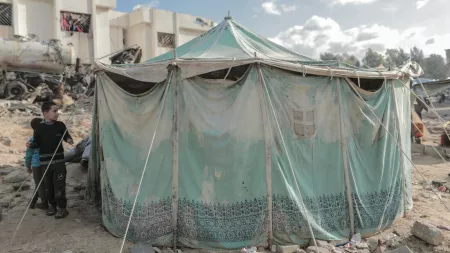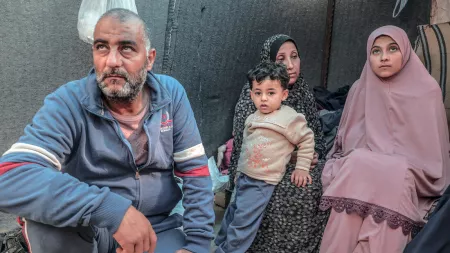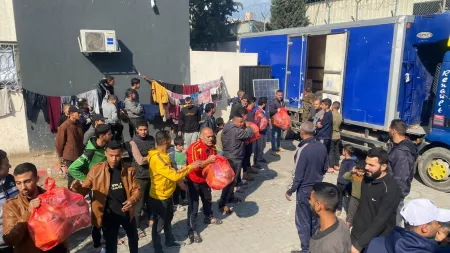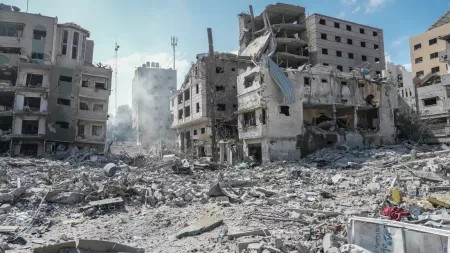A CARE humanitarian worker* went to Gaza on a five-day mission to support the national team in increasing aid provision. With over 20 years of experience in large-scale crises, they* have already witnessed war, famine, and natural disasters multiple times. But what was seen in Rafah was unlike anything they had ever experienced.
*The identity of the humanitarian worker will not be disclosed for security reasons
Before I went to Gaza, I was told how important it would be to emotionally prepare for what I would see and hear. I have worked in numerous disaster and conflict zones over the past 20 years, I have seen war, I have seen people affected by natural disasters and famines in countries such as Afghanistan, Syria, Somalia, Nigeria and Iraq. I have followed the news about the ongoing bombardment of Gaza, and I knew that the entire population of 2.2 million is on the brink of famine, and that over 100,000 people are dead, injured or missing. I also knew that there is limited medical care and a major shortage of clean water, and safe shelters. However, nothing could have possibly prepared me for what I witnessed during my five-day mission to Rafah to support our team in scaling up assistance.
A blockage between people in need and aid
I set out early in the morning from Cairo, and after many hours of driving, waiting, and passing through checkpoints, I reached the border with Gaza. The first thing that struck me as I approached the Rafah crossing, was the backlog of trucks, columns of trucks, for as far as I could see. I knew that on average, only around 100-150 trucks are able to enter Gaza each day, while more than 500 would be needed to meet at least the most basic needs of people stuck in the Gaza Strip. But seeing it with my own eyes really took my breath away.
All these trucks, filled with food, shelter materials, hygiene items, warm blankets, and clothes people so desperately needed, are simply stuck because access to humanitarian aid is repeatedly denied or impeded.
Gaza: A moonscape for a land
Driving to Rafah, I saw the destruction of houses flattened by the bombings. Approximately 70% of Gaza’s homes have been destroyed, and I can only imagine how much worse the situation is in the North, succinctly described as a “moonscape of war” based on the analysis of satellite images. Rafah, an area of only 65 km2 – less than half the size of Liechtenstein – has become home to at least 1.4 million people who are fleeing from intensified fighting in Khan Younis and other areas. Before the recent war, around 260,000 people lived in Rafah. The UN recently compared Rafah to a “pressure cooker of despair”, which really is an accurate way of describing it.
Makeshift Shelters: A living reality
I was blown away by the sheer volume of people in Rafah, who have fled the destruction further north and in some instances, been displaced multiple times. The streets are full of people, donkey and horse carts. People are everywhere, putting up plastic sheets as improvised shelters by the side of the roads. They were told to leave their homes or places of refuge by the Israeli military and, according to some accounts, were told to take nothing with them. Shelters in schools, community centres, and hospitals are completely overcrowded, so people are now simply establishing makeshift shelters anywhere there is space available. Every day I was in Rafah, the number of people grew; it was visible in the streets we drove through. By the time I left, the daily expansion of makeshift shelters was evident.

Many of the families displaced into Rafah came only with the clothes they were wearing. You see children in summer clothes, some walking around barefoot or in sandals in the cold winter months. The prices in the markets have increased by an average of 600%, and many commodities are not available at all. People I spoke to told me there were no diapers, no children’s clothes, no baby formula, and no sandals available. People have run from bombs and destruction so many times, that the soles of their shoes have literally worn out or their shoes have become damaged beyond repair. I heard stories of families having to rent shoes to people who no longer have any shoes at all. Having to walk to the market or somewhere to collect water, some people are paying an hourly fee to rent shoes, so they do not have to walk barefoot.
Never, ever have I seen such desperation and despair.
The plastic sheets people set up are vulnerable to heavy rain and winds, with temperatures in the single digits at night. Around 10% of the people in Gaza already suffer from severe respiratory diseases, and hundreds of thousands suffer from diarrhea. It is a miracle there has not been a cholera outbreak yet.
A life of constant fear
What I will never forget is the look on people’s faces. You can see the distress and grief imprinted on their faces. I will never forget the fear on elderly people’s faces, and mothers’ eyes who appear to have lost all hope. Every minute of my time in Gaza I heard the loud buzzing of drones, at times interrupted by the sound of larger crewed aircraft, explosions, crying, wailing, and ear-piercing screams. Passing donkey carts on the street, you see women and children with blank expressions, a look on their faces I have only before seen in people experiencing post-traumatic stress disorder.

A glimpse of hope
Amid all of this desperation, hunger, fear, and grief, working with my colleague Saaed and our local partners in Gaza was what instilled hope in me, what showed me the impact of our work, and what is possible if aid gets through. Saaed is leading our work on the ground in Gaza, and thanks to him and his endless efforts, we were able to reach over 170,000 people with water, hygiene kits, medical support, and shelter kits.
Humanitarians like him work relentlessly to help hundreds of thousands of people in need, and they do so under the constant threat of being harmed themselves. More than 150 humanitarian workers have already lost their lives since October.
Saaed told me about his children and how they ask him every morning not to leave the house when he kisses them goodbye. His commitment is remarkable and makes the sight of hundreds of trucks waiting to pass into Gaza even harder to stomach.

While I was in Gaza, two of our trucks with shelter materials finally reached our designated warehouse. At this moment, the expressions of Saaed and our partners’ faces changed to ones of palpable relief, a small achievement that made us forget the chaos, if only for a moment. Within hours, my colleagues were planning for the upcoming distribution to ensure the aid quickly reached those who so desperately need it.
Ceasefire NOW.
Leaving Gaza was hard, especially given the knowledge that Rafah too might be invaded and my colleagues and the over one million people living there have nowhere safe to go to. It is evident what Palestinian families need. They need a lasting ceasefire, an end to this war, and urgently need water, food, a safe place to sleep, and medicine. They need everything that will help those who survived the hostilities live a life where at least their basic needs are covered.
But right now, our hands are tied. My colleagues in Gaza not only have to deal with the horrors of this war, but also they can only distribute what humanitarian assistance is allowed to enter Gaza, in what humanitarian space remains. The women, men, and children I have seen and spoken to, the people who so desperately need medicine for loved ones, who want to feed their daughters and sons and cover them with a warm blanket in cold winter nights, could simply die of hunger and disease because access to aid is denied or hindered.
We need a sustained ceasefire NOW to end further loss of civilian life, and to do our work safely. Palestinians in Gaza have suffered more than I thought was humanly possible.
